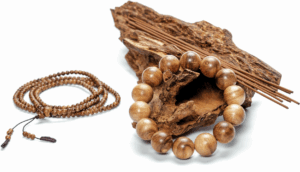Agarwood
Agarwood is a solid aromatic substance formed from a complex mixture of resin, gum, volatile oils, and wood fibers. It is not a naturally fragrant timber in its original state, but rather a new material that develops within an agarwood tree under specific environmental and biological conditions.
When trees of the Aquilaria genus (family Thymelaeaceae) are damaged by natural events such as wind, lightning, or landslides, or by animals, insects, or human activity, they secrete resinous substances to heal the wound. During this process, the injured area often becomes infected by fungi such as Aspergillus, Penicillium, or Fusarium. The parenchyma cells in the tree’s wounded tissue undergo biochemical changes: starch and other stored compounds transform into aromatic precursors like benzylacetone. Over time, and under the continuous influence of fungi, these intermediate compounds gradually convert into agarwood resin.
The longer this transformation, accumulation, and natural aging continue, the richer and more complex the resulting aroma becomes. The content of key aromatic molecules—such as 2-(2-phenylethyl)chromone and various sesquiterpenes (including agarospirol and jinkoh-eremol)—increases significantly. These compounds determine the depth, persistence, and overall quality of agarwood. Because the resinous wood often sinks when placed in water, it earned the name Chenxiang (literally “sinking fragrance”). However, not all agarwood is dense enough to sink; only those with long resin formation periods exhibit this trait.
The formation of agarwood is an intricate natural process influenced by numerous factors—many of them accidental. Geographic origin, tree species, age of resin formation, whether the tree was alive or dead at the time, environmental conditions, and even unknown variables together shape the quality and characteristics of each piece.
There are about twenty-three known species of Aquilaria, distributed mainly in southern and southwestern China, as well as in Vietnam, Cambodia, Thailand, Myanmar, Laos, northeastern India, Bhutan, the Philippines, Malaysia, Indonesia, Brunei, and Papua New Guinea. Although the natural range of agarwood trees is extensive, their density in the wild is extremely low. Wild agarwood is now exceedingly rare due to decades of overharvesting and ecological destruction.
Historically, China’s native species—particularly Aquilaria sinensis—were abundant, thriving in mountainous or hilly regions below 1,000 meters and south of 24°N latitude. Yet as agarwood prices have soared, uncontrolled logging and transplanting have decimated wild populations, leaving only small remnants of what once were vast natural stands.
At room temperature, agarwood’s fragrance is subtle and restrained. When the temperature rises to around 35°C (95°F), its aroma begins to unfold. When gently heated, a single piece of agarwood can release a layered spectrum of scents—floral, honeyed, fruity, creamy, cool, bitter, sour, salty, medicinal, even lightly smoky notes—all blending into a remarkably complex harmony. This multidimensional fragrance arises from the intricate structure of its natural aromatic compounds, which remain impossible to replicate synthetically.
Agarwood’s aromatic molecules are notably stable and slow to evaporate, allowing its fragrance to linger for many years. Another defining feature is its exceptional diffusion and depth: the scent travels far yet remains grounding and meditative, unlike the airy sweetness of most floral or fruity perfumes. It draws attention, quiets the mind, and evokes a profound sense of serenity and mystery—qualities that have made agarwood deeply revered across cultures and centuries.
![图片[1]-What is agarwood?-Crowee Incense](https://www.crowee.com/wp-content/uploads/2025/11/agarwood-crowee-incense-1024x683.png)
![图片[2]-What is agarwood?-Crowee Incense](https://www.crowee.com/wp-content/uploads/2025/11/agarwood1-crowee-incense.png)
![图片[3]-What is agarwood?-Crowee Incense](https://www.crowee.com/wp-content/uploads/2025/11/agarwood3-crowee-incense-1024x492.png)




暂无评论内容